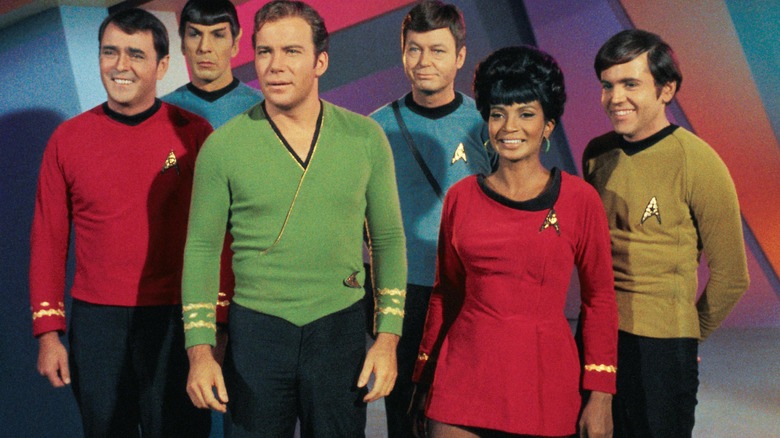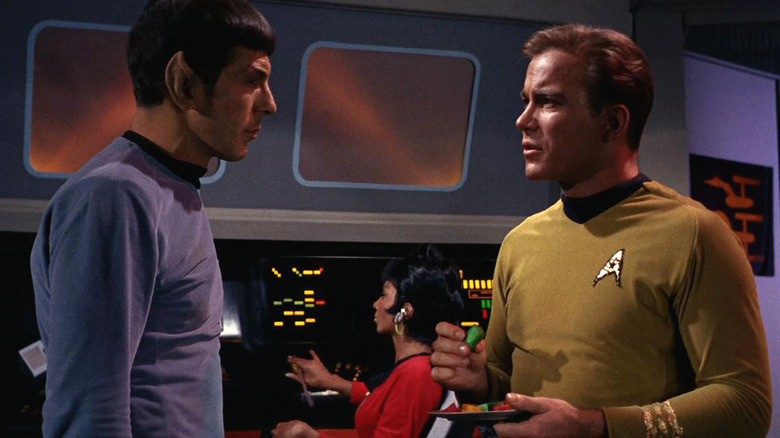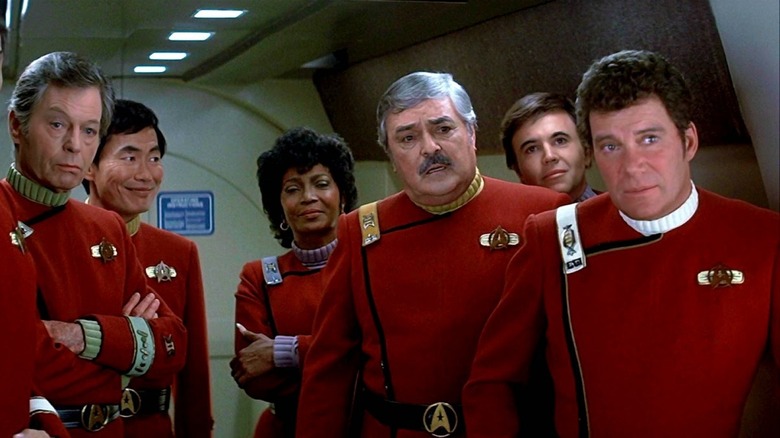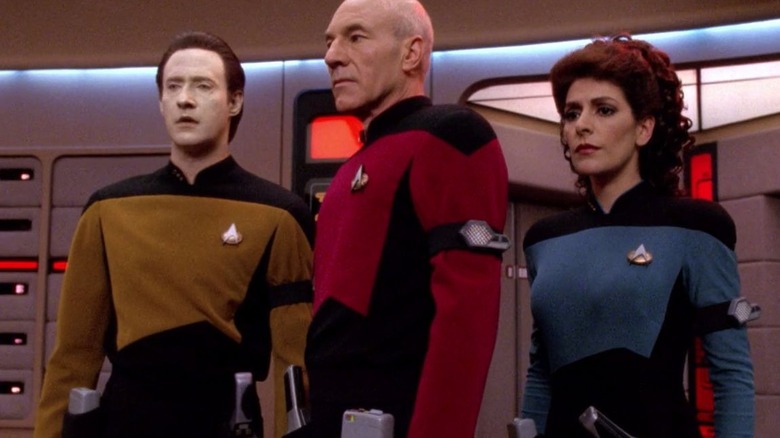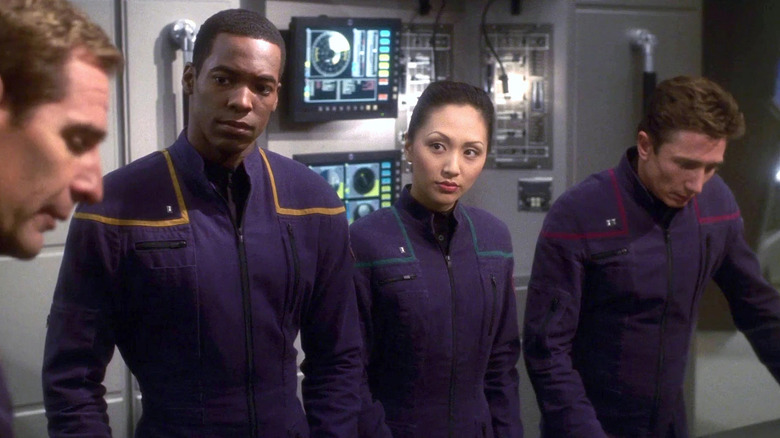Star Trek's Different Uniform Colors And Their Meanings Explained
The Starfleet uniforms seen on the original "Star Trek" series back in 1966 were designed by William Ware Theiss, a costume designer who had previously worked on major Hollywood productions like "Spartacus," and who would go on to design for films like "Harold & Maude," "Bound for Glory," and "Pete's Dragon." According to an article on StarTrek.com, Theiss became friends with D.C. Fontana on the set of "Spartacus" (Fontana worked as a member of the studio's typing pool), which gave him the connection he needed to land his "Star Trek" job. It was Theiss' idea to make futuristic space uniforms look more shirt-like and casual, which stood in contrast to the shiny-and-chrome sci-fi costumes that were more in vogue at the time.
Theiss was also notorious for the skin-revealing outfits he designed for the show's many female guest stars, and he was noted for being able to ride the line of acceptability when it came to nudity. He was a talented man whose name should be more widely known by Trekkies.
The actual colors of the Starfleet uniforms, however, were decided by committee (with Fonanta and show creator Gene Roddenberry giving input), so Theiss went along with the idea that the various workers on a Federation starship should be color-coded by their respective departments. Little could Theiss have known that the Starfleet department colors would remain a permanent fixture in a media franchise that would last (as of this writing) 57 years.
As far as Starfleet is concerned, there are three central departments on a Starfleet vessel: Gold is for command, blue is for science/medical, and red is for engineering/security. In the days of "Star Trek: The Next Generation," the red and gold would be inverted. Theiss won an Emmy for "Next Generation" before his death in 1992.
Gold, red, blue, and other uniform colors
In the original "Star Trek," for instance, one might note that Captain Kirk (William Shatner) wore a gold uniform. That was to denote his position in management. Other lower-ranking officers in gold uniforms were essentially on the "management track," presumably learning about all departments on a starship and hoping to command a vessel of their own someday (or at least become a first officer).
Those in the red uniforms worked with the technical aspects of a ship. Scotty (James Doohan) and Uhura (Nichelle Nichols) dealt with machinery, engines, communication devices, etc. Red was also used for security officers on the U.S.S. Enterprise, which may be why so many redshirts died on away missions; they were ancillary security officers. Red uniforms were also worn by yeomen, who essentially helped with clerical work and didn't have a rank. It's worth noting that in the canon of "Star Trek," engineers, yeomen, and security officers don't have to attend Starfleet Academy to serve on board a starship. One can simply enlist. Those officers answer to the heads of their respective departments.
Those in blue, like Spock (Leonard Nimoy) and Dr. McCoy (DeForest Kelley), are in charge of scientific research and medicine. A lot of "Star Trek" is devoted to the sciences, so it makes sense that it would be an active and enormous part of any ship. The science/medical department is pretty self-explanatory.
One might note that Kirk occasionally wore a green tunic with a V-neck collar. The green uniform didn't denote any unique department and seemed to be a regulation fashionable alternate for starship captains. If a captain was bored with their standard gold uniform, they were allowed — on casual Fridays? — to wear the green one. (Trivia: the golden uniforms were supposed to be green, but the combination of '60s TV lighting, cameras, and budgetary concerns led to them appearing yellow on camera and the crew deciding to simply stick with it rather than change anything. Kirk's alternate green uniform, made with a different fabric that photographed more accurately, showcases the original intended look.)
The all-red uniforms
In director Robert Wise's 1979 film "Star Trek: The Motion Picture," the uniforms were updated. The crew all wore disco-ready bodysuits that were, likewise, color-coded by department. Command officers now wore all-white outfits, science officers wore a muter steel blue, and engineers wore a muted golden brown. Looking close, one might also note that the Starfleet insignias on officers' left lapels were also color-coded, and the coloring system seemed to be more elaborate for the badges. Command officers wore white, science officers wore orange, medical officers wore green, engineers wore red, operations officers wore gold, and security officers wore silver. "The Motion Picture" was the only "Star Trek" outing to use this code.
"Star Trek: The Motion Picture" also revealed that officers seemed to have many fashionable alternatives to their standard uniforms, and multiple uniform cuts and tunics could be seen around the ship. Occasionally, it seems that Starfleet goes through fashion phases where it becomes lax and less stringent about the uniformity of its uniforms. These "any uniform will do" phases seem to last about a year before Starfleet cracks down again.
Hence, in "Star Trek II: The Wrath of Khan," a new standard was put into place, and the all-red, Christmas sweater-like uniforms (seen in the picture above) would remain the standard through at least the 2350s when the Enterprise-C was commissioned. Those uniforms looked awfully hot but had button-down, shoulder-fastened chest flaps that could be opened to cool off a little. One might note that the subtle department colors were included on the uniform's collars, cuffs, and shoulder straps. Command officers wore white, engineer/security officers wore orange, and science/medical officers wore grey.
The red/gold flip
William Ware Theiss returned to "Star Trek" to design the uniforms seen on "Star Trek: The Next Generation," and the design reverted to the red/gold/blue color coding from the original series, only now with the red and the gold reversed; commander officers like Captain Picard (Patrick Stewart) wore red while engineering/security now wore gold. There has been no explanation in the canon of "Star Trek" as to why the department colors flipped. Some fans have theorized the red/gold flip was a production decision made to confront the "redshirts always die" cliché that has wormed its way into the Trekkie's pop consciousness. If the captain wore red, then audiences would no longer assume that those in red uniforms were doomed.
The "Next Generation" color coding system has stayed in place until this day. Those colors remained unchanged in "Star Trek: Deep Space Nine," "Star Trek: Voyager," and the four "Next Generation"-inspired feature films. More recently, "Star Trek: Lower Decks," which takes place about 10 to 15 years after "Next Generation," boasts the same coding. The general uniform designs have changed a lot, but the coloring remains consistent.
On "Next Generation," Picard also might be seen wearing a grey uniform with a suede-like red jacket thrown over it. Like Kirk's green tunic, this seems to be a special fashion dispensation for captains. One might also note that Wesley Crusher (Wil Wheaton), who served as an acting ensign on the U.S.S. Enterprise-D, wore a grey/dark grey body suit. This was the uniform given to provisional officers; Wesley hadn't gone to Starfleet Academy yet and wasn't an official ensign.
The distant past, the distant future
The 2001 series "Star Trek: Enterprise" is set a century before the events of the original "Star Trek," and the show's costume designers came up with a wonderful uniform design that rests comfortably on a timeline between NASA and Kirk. The crew all wore functional, indigo-colored jumpsuits, replete with pockets and zippers, that bore their department colors on stripes seen over their shoulders. Because "Enterprise" takes place long before the notorious red/gold flip, command officers still bear gold stripes, while engineering/security officers wear red ones. The science officers have always worn blue.
Also set before the events of the original "Star Trek" was the 2017 series "Star Trek: Discovery," which featured a pretty drastically different uniform design. The characters wore all-blue uniforms that featured chrome-encrusted highlights on their sides and wrapped around their shoulders to denote their departments. On "Discovery," command officers wore shiny gold, science officers wore shiny silver, and engineering/security officers wore shiny bronze. Medical officers were permitted to wear all-white uniforms, a trend also seen in the chronologically concurrent "Star Trek: Strange New Worlds." That series adhered more directly to the 1966 designs and colors.
In the third season of "Discovery," a time warp threw the characters into the 32nd century, and, naturally, Starfleet uniforms had changed. The cut of the uniform was very different; the ranking pips were displayed in multiple ways all over an officer's body. Sometimes, the uniforms were grey with department colors denoted on down-the-chest stripes. Sometimes, they were all one color.
For clarity's sake, however, the "Next Generation" era color coding remained intact on 32nd-century "Discovery," something that seems to have lasted the better part of a millennium. The biggest change: medical officers now wear white instead of blue.
